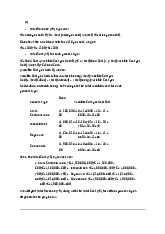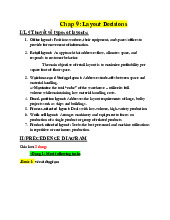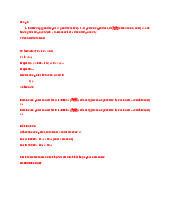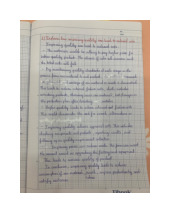





Preview text:
lOMoAR cPSD| 58097008
7.1: Southeastern Oklahoma State University’s business program has the facilities
and faculty to handle an enrollment of 2,000 new students per semester. However,
in an effort to limit class sizes to a “reasonable” level (under 200, generally),
Southeastern’s dean, Holly Lutze, placed a ceiling on enrollment of 1,500 new
students. Although there was ample demand for business courses last semester,
conflicting schedules allowed only 1,450 new students to take business courses.
What are the utilization and efficiency of this system? Solution:
Design capacity of the University is 2,000 students: Given,
Actual intake = 1,450 students
Design capacity = 2,000 students Actualintake 1,450
Utilization = Designcapacity = 2,000 = 72.5%
Design capacity of the University is 1500 students:
Actual intake = 1,450 students
Design capacity = 2,000 students Actualintake 1,450
Utilization = Designcapacity = 1,500 = 96.67%
Placed a ceiling on enrollment of 1,500 new students will be more efficient
7.5: Material delays have routinely limited production of household sinks to 400
units per day. If the plant efficiency is 80%, what is the effective capacity? Solution:
Effective capacity is calculated by dividing the actual capacity by efficiency. lOMoAR cPSD| 58097008 actualcapacity
Effective capacity = efficiency Effective capacity =
Effective capacity = 500 units
7.11: The three-station work cell illustrated in Figure S7.7 has a product that must
go through one of the two machines at station 1 (they are parallel) before proceeding to station 2.
a) What is the bottleneck time of the system?
b) What is the bottleneck station of this work cell?
c) What is the throughput time?
d) If the firm operates 10 hours per day, 5 days per week, what is the
weeklycapacity of this work cell? Solution:
Following are the cycle time (Throughput time) which is the time taken for
producing (processing) a unit for each station: Station 1 = 60/20 = 3 Minutes lOMoAR cPSD| 58097008 Station 2 = 60/5 = 12 Minutes Station 1 = 60/12 = 5 Minutes a) 12 Minutes b) Station 2
c) Throughput time of the system = 3 + 12 + 5 = 20 Minutesd)
Weekly available time = 600 Minutes (10 hours) * 5 days = 3000 Minutes
Time taken to produce one unit (Throughput time) = 20 Minutes
Weekly Capacity = Weekly available time / Throughput time = 3000/20 Weekly Capacity = 150 units
7.12: The three-station work cell at Pullman Mfg., Inc. is illustrated in Figure
S7.8. It has two machines at station 1 in parallel (i.e., the product needs to go
through only one of the two machines before proceeding to station 2). a) What is
the throughput time of this work cell?
b) What is the bottleneck time of this work cell?
c) What is the bottleneck station?
d) If the firm operates 8 hours per day, 6 days per week, what is the
weeklycapacity of this work cell? Solution:
a. Throughput time = 20+12+8= 40 minutes
b. Bottleneck time = 12 minutes lOMoAR cPSD| 58097008
c. Bottleneck station is station 2 d. Weekly capacity = = 240 units
Hence, the weekly capacity of this work cell is 240 units per week
7.15: Smithson Cutting is opening a new line of scissors for supermarket
distribution. It estimates its fixed cost to be $500.00 and its variable cost to be
$0.50 per unit. Selling price is expected to average $0.75 per unit. a) What is
Smithson’s break-even point in units?
b) What is the break-even point in dollars? Solution:
Given data: Fixed cost = $500.00.
Variable cost = $0.50 per unit.
Selling price = $0.75 per unit.
a) The Break-even point in units = Selling
price perunit¿cost−Variablecost perunit $500.00 = $ 0.75−$0.50 = 2,000 units.
b) The Break-even point in dollars = Selling price per unit * Break even in units = $0.75 * 2,000 = $1,500. lOMoAR cPSD| 58097008
7.17: Markland Manufacturing intends to increase capacity by overcoming a
bottleneck operation by adding new equipment. Two vendors have presented
proposals. The fixed costs for proposal A are $50,000, and for proposal B,
$70,000. The variable cost for A is $12.00, and for B, $10.00. The revenue
generated by each unit is $20.00.
a) What is the break-even point in units for proposal A?
b) What is the break-even point in units for proposal B? Solution: a) For A: 50000 +12x = 20x x = 6250 b) For B: 70000 + 10x =20x x = 7000
7.20: Janelle Heinke, the owner of Ha’Peppas!, is considering a new oven in
which to bake the firm’s signature dish, vegetarian pizza. Oven type A can handle
20 pizzas an hour. The fixed costs associated with oven A are $20,000 and the
variable costs are $2.00 per pizza. Oven B is larger and can handle 40 pizzas an
hour. The fixed costs associated with oven B are $30,000 and the variable costs
are $1.25 per pizza. The pizzas sell for $14 each. a) What is the break-even point for each oven?
b) If the owner expects to sell 9,000 pizzas, which oven should she purchase?
c) If the owner expects to sell 12,000 pizzas, which oven should she purchase?
d) At what volume should Janelle switch ovens? Solution: a) Break-even point =
Contribution¿costperunit $20,000 = 14−2 = 1666,67 lOMoAR cPSD| 58097008 Break-even point =
Contribution¿costperunit $30,000 = 14−1.25 = 2352.94 b) Total revenue from A Total revenue from B Sales 126000 126000 Less: Variable cost 18000 11250 Contribution 108000 114750 Less: Fixed cost 20000 30000 Net revenue 88000 84750
Hence, A should be purchase because net revenue is more than B c) Total revenue from A Total revenue from B Sales 168000 168000 Less: Variable cost 24000 15000 Contribution 144000 153000 Less: Fixed cost 20000 30000 Net revenue 124000 123000
Hence, A should be purchase because net revenue is more than B d) Indefference point =
variable¿costcost = 30,000−20,000 = 13,333.33



